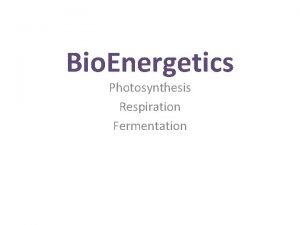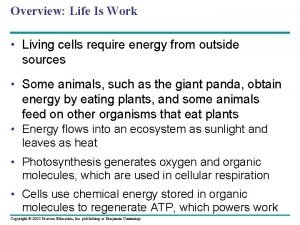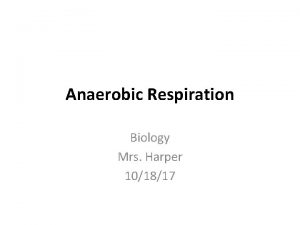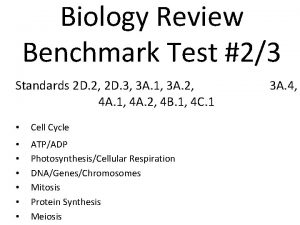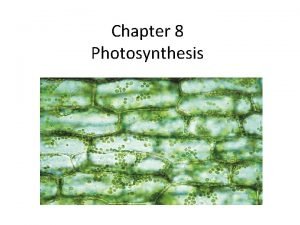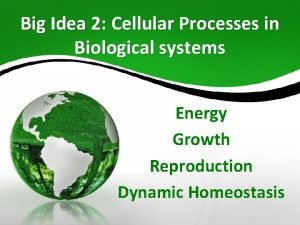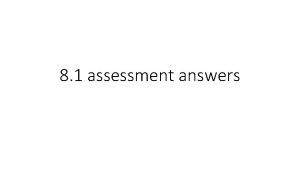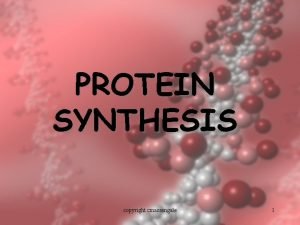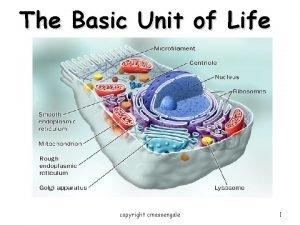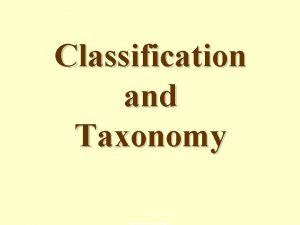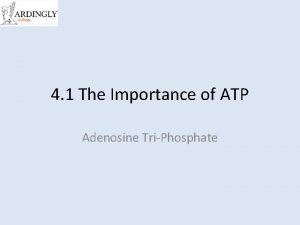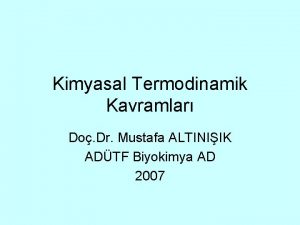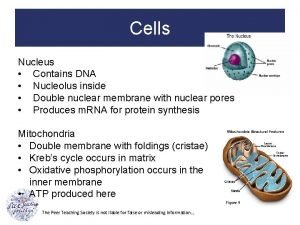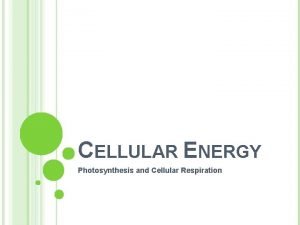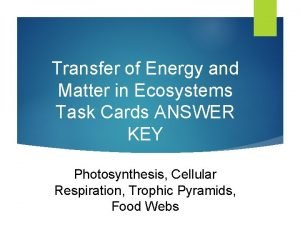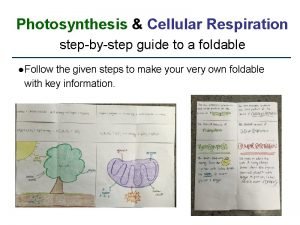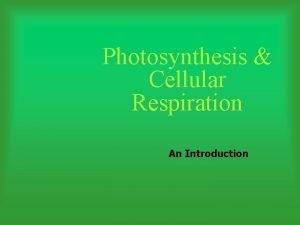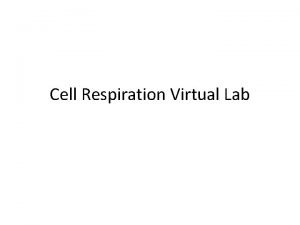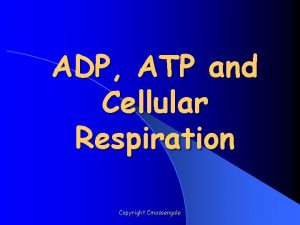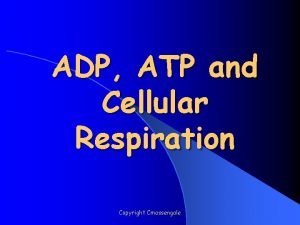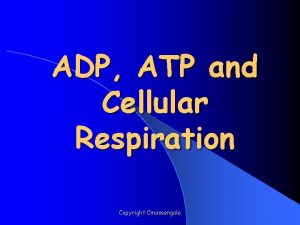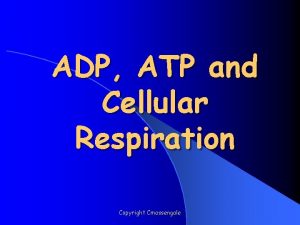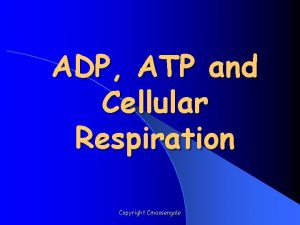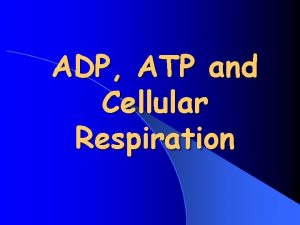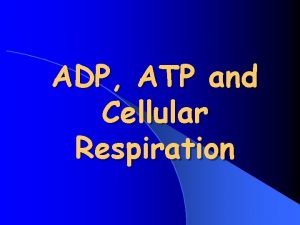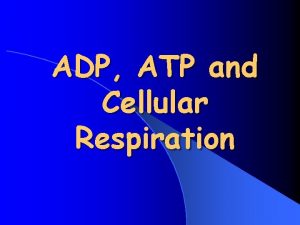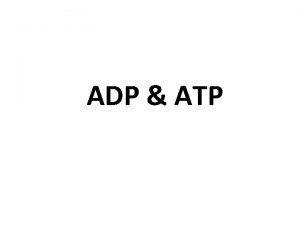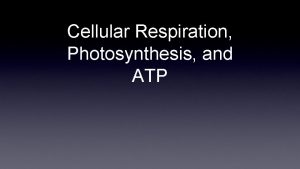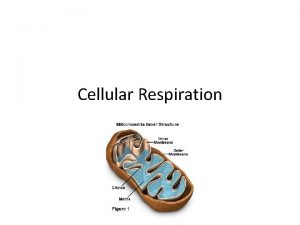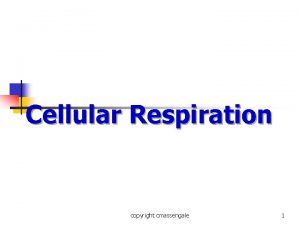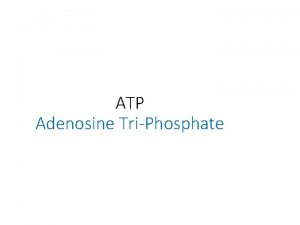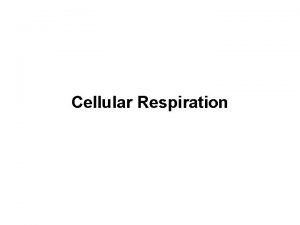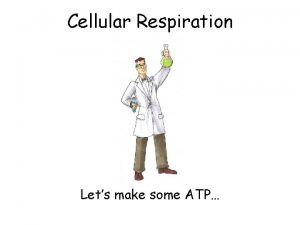ADP ATP and Cellular Respiration Copyright Cmassengale What




























- Slides: 28

ADP, ATP and Cellular Respiration Copyright Cmassengale

What Is ATP? Energy used by all Cells Adenosine Triphosphate Organic molecule containing highenergy Phosphate bonds Copyright Cmassengale

Chemical Structure of ATP Adenine Base 3 Phosphates Ribose Sugar Copyright Cmassengale

What Does ATP Do for You? It supplies YOU with ENERGY! Copyright Cmassengale

How Do We Get Energy From ATP? By breaking the highenergy bonds between the last two phosphates in ATP Copyright Cmassengale

What is the Process Called? HYDROLYSIS (Adding H 2 O) H 2 O Copyright Cmassengale

How Does That Happen? An Enzyme! Copyright Cmassengale

How is ATP Re-Made? The reverse of the previous process occurs. Another Enzyme is used! ATP Synthetase Copyright Cmassengale

The ADP-ATP Cycle ATP Synthetase ATP-ase Copyright Cmassengale

When is ATP Made in the Body? During a Process called Cellular Respiration that takes place in both Plants & Animals Copyright Cmassengale

Cellular Respiration l l Includes pathways that require oxygen Glucose is oxidized and O 2 is reduced Glucose breakdown is therefore an oxidation-reduction reaction Breakdown of one glucose results in 36 to 38 ATP molecules Copyright Cmassengale

Overall Equation for Cellular Respiration C 6 H 12 O 6 + 6 O 2 YIELDS 6 CO 2 + 6 H 20 + e- + 36 -38 ATP’s Copyright Cmassengale

Other Cellular Respiration Facts l Metabolic Pathway that breaks down carbohydrates l Process is Exergonic as High-energy Glucose is broken into CO 2 and H 2 O l Process is also Catabolic because larger Glucose breaks into smaller molecules Copyright Cmassengale

What are the Stages of Cellular Respiration? l Glycolysis l The Krebs Cycle l The Electron Transport Chain Copyright Cmassengale

Where Does Cellular Respiration Take Place? l It actually takes place in two parts of the cell: Glycolysis occurs in the Cytoplasm Krebs Cycle & ETC Take place in the Mitochondria. Copyright Cmassengale

Review of Mitochondria Structure l Smooth outer Membrane l Folded inner membrane l Folds called Cristae l Space inside cristae called the Matrix Copyright Cmassengale

Diagram of the Process Occurs across Cristae Occurs in Cytoplasm Occurs in Matrix Copyright Cmassengale

Glycolysis Summary Takes place in the Cytoplasm Anaerobic (Doesn’t Use Oxygen) Requires input of 2 ATP Glucose split into two molecules of Pyruvate or Pyruvic Acid Copyright Cmassengale

Glycolysis Summary Also produces 2 NADH • Pyruvate is oxidized to and CO 2 is removed • Copyright Cmassengale and 4 ATP Acetyl Co. A

Glycolysis Diagram Copyright Cmassengale

Fermentation v Occurs when O 2 NOT present (anaerobic) v. Called Lactic Acid fermentation in muscle cells (makes muscles tired) v. Called Alcoholic fermentation in yeast (produces ethanol) v. Nets only 2 ATP Copyright Cmassengale

A Little Krebs Cycle History Discovered by Hans Krebs in 1937 l He received the Nobel Prize in physiology or medicine in 1953 for his discovery l Forced to leave Germany prior to WWII because he was Jewish Copyright Cmassengale l

Krebs Cycle Summary l Requires Oxygen (Aerobic) l Cyclical series of oxidation reactions that give off CO 2 and produce one ATP per cycle l Turns twice per glucose molecule l Produces two ATP l Takes place in matrix of mitochondria Copyright Cmassengale

Krebs Cycle Summary l Each turn of the Krebs Cycle also produces 2 ATP, NADH and FADH 2 + CO 2 Copyright Cmassengale

Krebs Cycle ATP Copyright Cmassengale

Electron Transport Chain Summary l 34 ATP Produced l H 2 O Produced l Occurs Across Inner Mitochondrial membrane Copyright Cmassengale

Electron Transport Chain Animation Copyright Cmassengale

Copyright Cmassengale
 Equation of cellular respiration
Equation of cellular respiration Atp formula cellular respiration
Atp formula cellular respiration Total atp produced in cellular respiration
Total atp produced in cellular respiration Overview of cellular respiration
Overview of cellular respiration Difference between atp and adp
Difference between atp and adp Meiosis 1
Meiosis 1 Atp and adp cycle
Atp and adp cycle Atp and adp cycle
Atp and adp cycle How living things obtain energy worksheet answers
How living things obtain energy worksheet answers Cmassengale
Cmassengale Cmassengale
Cmassengale Taxonomy groups
Taxonomy groups Role of atp
Role of atp Atp adp dönüşümü
Atp adp dönüşümü Termodinamik
Termodinamik Is the nucleolus inside the nucleus
Is the nucleolus inside the nucleus Complimentary processes
Complimentary processes Equation for cell respiration
Equation for cell respiration Function of cellular respiration
Function of cellular respiration Where does cellular respiration take place
Where does cellular respiration take place Photosynthesis and cellular respiration foldable
Photosynthesis and cellular respiration foldable Where does the oxygen that we breathe come from edpuzzle
Where does the oxygen that we breathe come from edpuzzle Photosynthesis and cellular respiration
Photosynthesis and cellular respiration Cell respiration virtual lab
Cell respiration virtual lab Some students are instructed to put a celery stalk
Some students are instructed to put a celery stalk Photosynthesis and cellular respiration jeopardy
Photosynthesis and cellular respiration jeopardy Cellular respiration redox
Cellular respiration redox The gray-brown haze often found over large cities is called
The gray-brown haze often found over large cities is called Cellular respiration steps
Cellular respiration steps

